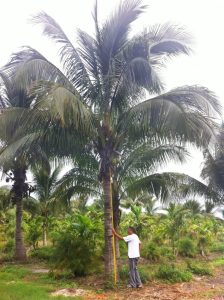How to Care for Palm Trees
Palm trees can quickly transform the look of your property. However, growing and caring for palm trees in some climates can be extremely challenging because most palm species are intolerant to frost. Warmer climates may be more suitable for growing palm trees. Nevertheless, all palm tree species require regular maintenance regardless of the climate. At Palmco, we offer our clients tips on how to care for palm trees to ensure their plants grow healthy and strong.
Tips for Caring for Palm Trees
 Preparation is a crucial component of palm tree care and maintenance. Choose the planting location for your palm trees carefully. Make sure the planting location has lots of organic matter spread out over a large area. Palm trees have extensive root systems. Therefore, their developing roots should have access to organic matter. Be sure to avoid burying the trunk of the palm tree during planting to prevent root rot. In addition, water the root ball adequately before backfilling the planting hole.
Preparation is a crucial component of palm tree care and maintenance. Choose the planting location for your palm trees carefully. Make sure the planting location has lots of organic matter spread out over a large area. Palm trees have extensive root systems. Therefore, their developing roots should have access to organic matter. Be sure to avoid burying the trunk of the palm tree during planting to prevent root rot. In addition, water the root ball adequately before backfilling the planting hole.
Spread mulch at least 2 meters from the trunk around the root zone to nourish the tree as the mulch composts with time. Be sure to replace the mulch each year.
As the palm tree grows, it will need supplemental watering to help it establish itself. Water your palm trees adequately during the first months of growth. The soil around your palm tree should not dry out entirely or become soggy. Dry soil may kill your palm tree, while soggy ground provides room for fungal growth.
Use different plant feeding systems depending on the season; for instance, foliar feeding in spring and granular feeding quarterly. Use granular feeding exclusively for plants that are older than one year. In addition, be sure to cut off dead fronds as they occur. If you want to maintain the size of the plant by pruning it, only cut off the bottom and mid fronds. Do not cut the top fronds of the tree.
Contrary to what many people believe, not all palm tree species are tropical plants. Lots of sunlight and water may kill some palm tree species, especially desert varieties that can drown with excessive watering. In addition, some palm tree species cannot survive without fertilizer. However, the right time for planting most palm tree species is during early spring. Therefore, know the palm tree species on your property to provide the required maintenance.
The size and growth habits of your palm trees determine how best to display them. Many species grow well both indoors and outdoors. In addition, palm trees can be grown in groups with other plants clustered at their base. Whatever location you choose for growing your palm trees, ensure it is not exposed to excessive traffic. Brushing and pulling caused by traffic may cause your palm trees to weaken and eventually die.
It is essential to know that most palm tree species are not likely to flower when grown indoors. Palm trees can grow to incredible heights with proper care. Unfortunately, top trimming palm trees is not recommended because the fronds of the tree grow from a central tip. Removing the tip may cause the tree to die.
Palm trees require minimal maintenance and can live in your landscape for many generations. Palmco offers guides to help you choose palm trees for your growing zone. If you are looking for a wholesaler for quality palm trees that ships worldwide, contact one of our representatives today. Please contact us today at (239) 283-1329 to learn more about how to care for palm trees.

